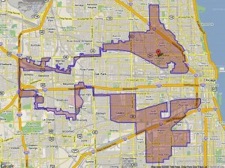By: Nathaniel Ament-Stone 
Once a decade, state legislators and judges around the country must redraw federal, state, and local district boundaries to reflect new Census figures. This cycle – though still incomplete as a handful of states wait to pass final state legislative or congressional plans – has already spawned several dozen lawsuits and a ruling by the Supreme Court.
Incumbent match ups are already taking their toll on states’ congressional seniority averages. In Ohio this month, iconoclastic anti-war Democratic Rep. Dennis Kucinich of Cleveland lost his party’s nomination to a fellow incumbent, 30-year veteran Rep. Marcy Kaptur from Toledo; and in Illinois, Tea Party favorite Rep. Adam Kinzinger, a 34-year-old freshman from the reaches of exurban Chicago, toppled ten-term Rep. Don Manzullo, an establishment conservative hailing from outstate Illinois. More incumbent casualties are sure to follow in states like Pennsylvania, California, and Missouri. Courts have drawn congressional or state legislative maps in New York, Texas, Colorado, Minnesota, Mississippi, and elsewhere in light of legislative gridlock and alleged violations of the Voting Rights Act. Even nonpartisan redistricting commissions, like those employed in California, Iowa, Idaho, and Arizona, have not escaped allegations of misconduct.
This decade’s round of district map wars has set records for sheer volume of redistricting-related litigation, even as an unprecedented number of states adopt purportedly apolitical methods of redrawing district lines. California’s Citizens Redistricting Commission, composed of equal numbers of Democratic, Republican, and unaffiliated commissioners, drew congressional and state legislative boundaries without regard to incumbents, prior lines, or election statistics. The resultant shakeup of state politics was met with howls from the California Republican Party, already outnumbered in both the congressional delegation and the state legislature and facing further losses under the new maps. Arizona Governor Jan Brewer, a Republican, attempted to disqualify the chairwoman of the Arizona Redistricting Commission on grounds a federal court deemed “flimsy,” but managed to slow a remap process bound to create competitive seats in former Republican strongholds. Partisan squabbles have emerged over commission-drawn state legislative maps in Idaho and New Jersey.
Where state legislators draw the lines, politics have loomed large. Missouri Republicans eliminated the district of St. Louis-area Rep. Russ Carnahan, scion of a local Democratic dynasty, while Democrats in neighboring Illinois drew a congressional map intended to pack GOP votes into a few rural and exurban swathes and swing the Chicago suburbs leftward. In North Carolina, Republicans aim to cram seven Democratic incumbents into a mere three seats and, here in Georgia, Democratic Rep. John Barrow of Savannah must run in more hostile territory under a new map that cements Republican dominance in the state
But the decade’s greatest soap opera appears to have played out in Texas. There, Republican legislators hoped to stave off surging minority populations and an expected rise in Lone Star Democratic fortunes over the next few years. To do so, a district court ruled, their maps had illegally diluted Hispanic voting power. But the district court’s alternative maps, proposed in late November, were soon invalidated by the U.S. Supreme Court as straying too far from the legislature’s intentions. Upon remand to the district court level, judges settled on interim maps for the 2012 election that slightly increase the number of Latino-majority congressional and State House districts while not noticeably remaking the state’s geography in favor of Democrats. Mammoth court battles still loom in other large states such as Florida, where Democrats allege that legislators ignored the rules set out in a pair of state constitutional amendments passed by voters in 2010.
Redistricting shakes up the membership of Congress and state legislatures nationwide once per decade. The levels of posturing, quibbling, and parochialism involved in redistricting today are not anomalous relative to previous decades. Yet for those engaged in the contentious (if arcane) art of drawing electoral boundaries, the process has never seemed more poisonous. In years past, reform-minded good government types advocated for nonpartisan commissions as a means of de-politicizing the cottage industry that is redistricting in 2012. Yet California and Arizona show us that even the most idealistic of remap procedures can turn remarkably messy remarkably fast. Gerrymandering – and allegations of gerrymandering – are cherished elements of American political culture; and from this vantage, it appears they are here to stay.

